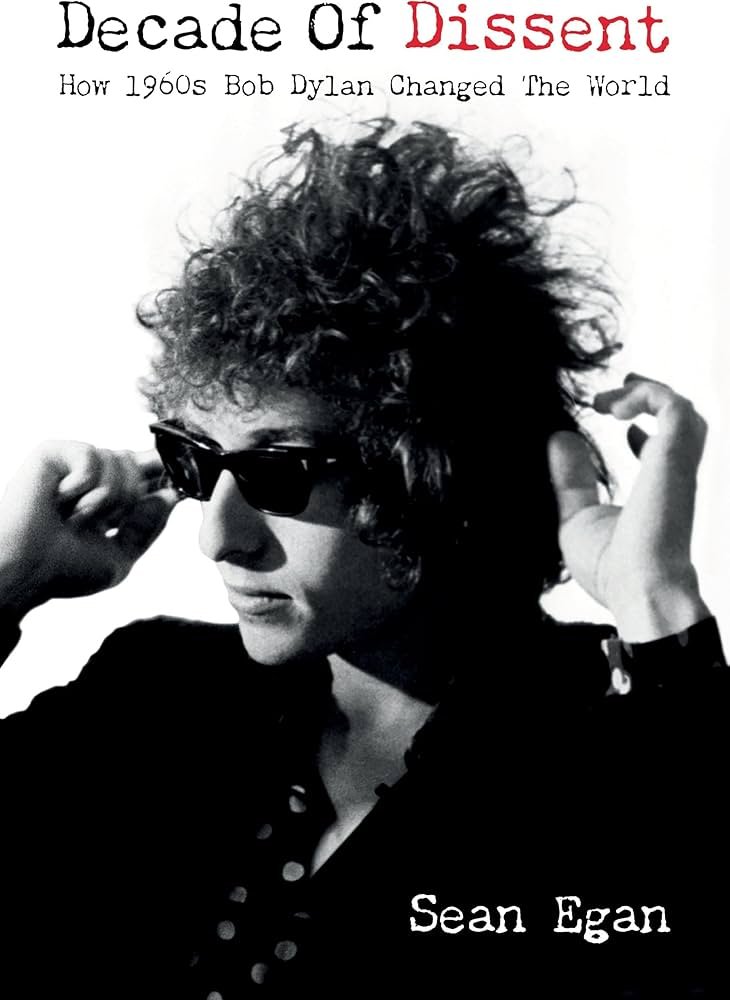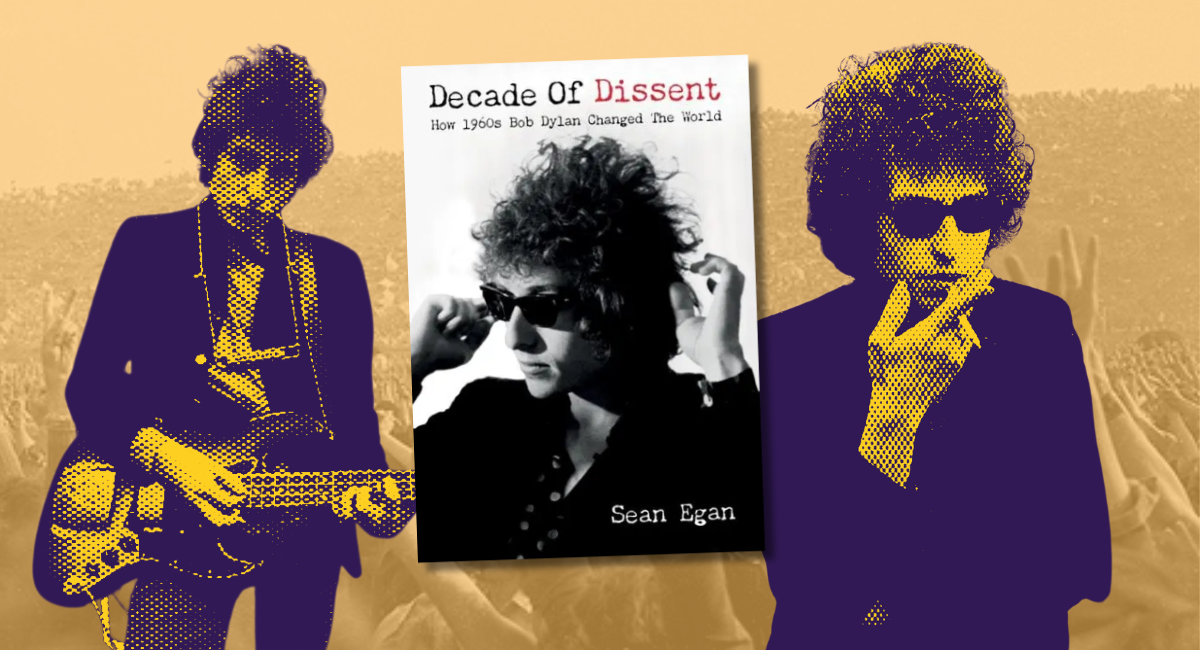Introduction: The Man Who Didn’t Want to Lead a Movement (So Naturally, He Led One)
Bob Dylan: the poet, the prophet, the reluctant poster boy for every scruffy revolutionary who’s ever waved a placard while avoiding eye contact. In Decade of Dissent: How 1960s Bob Dylan Changed the World, Sean Egan masterfully documents the most influential phase of Dylan’s career – the part where the man basically changed the cultural and political landscape of an entire decade while mumbling through harmonica solos and pretending he didn’t care.
Published in 2025 but fixated on the decade that gave us LSD, Vietnam and actual hope, Egan’s book isn’t just another fanboy valentine. It’s a sharply observed, sometimes damning and frequently funny deep dive into how a Jewish kid from Minnesota with a thing for Woody Guthrie became the voice of a generation – whether he bloody wanted to or not.
Table of Contents

Chapter One: From Hibbing to History
Egan opens by painting a picture of Dylan’s unlikely origins. Born Robert Zimmerman in 1941 in the snow-sodden town of Hibbing, Minnesota (population: nobody famous), Dylan soon realised two things: (1) small-town life is intolerable and (2) sounding vaguely like a Depression-era drifter gets you gigs in New York.
By the time Dylan arrived in Greenwich Village in the early ’60s, he was already mythologising himself. He’d dropped his surname, affected a voice that sounded like it had been fermented in whiskey and rolled in gravel and began churning out folk songs like he had a deadline from God. Egan doesn’t shy away from Dylan’s opportunism here. In fact, he seems to admire it. Reinvention, after all, is a rock star’s only real currency.
Chapter Two: “Blowin’ in the Wind” – The Anthem for People Who’d Like to Complain Politely
The book details how The Freewheelin’ Bob Dylan (1963) launched Dylan into orbit. “Blowin’ in the Wind” became a protest anthem despite sounding like a fortune cookie written during an existential crisis. Civil Rights activists adopted it. Schoolteachers played it. Even your gran probably hums it when the Wi-Fi’s down.
Egan deftly weaves in political context – Vietnam, segregation, the Bay of Pigs – without letting the history lesson overshadow Dylan’s story. Instead, the politics are the backdrop to an artist who, quite frankly, was just trying to write good songs and avoid eye contact with Joan Baez.
Chapter Three: From Protest to Psychedelia – Because Acoustic Guitars Are Boring
By 1965, Dylan had traded in his folk purity for electric guitars and amp stacks. Enter Highway 61 Revisited and Like a Rolling Stone, a song that Egan describes as “six minutes of sneering existential poetry set to a backbeat that slaps like divine punishment.”
Folk purists reacted as though Dylan had eaten a baby on stage. But Egan rightly frames this as the moment rock music stopped being about teenage romance and started being about alienation, absurdity and how crap everything is under capitalism. So, you know, progress.
This section of the book is perhaps the most vivid, as Egan details the infamous 1966 world tour – Dylan in sunglasses, wired on amphetamines, being called “Judas” by his own fans. It’s here that the legend begins to resemble a Greek tragedy… if Greek tragedies had harmonicas and terrifyingly wide lapels.
Chapter Four: The Motorcycle Crash That May or May Not Have Happened
Ah yes, the Great Retreat. After a mysterious motorcycle accident in 1966 (described in the book with the sort of ambiguity usually reserved for UFO sightings), Dylan vanishes from public view. He resurfaces a year later looking suspiciously like someone who’s been gardening and watching a lot of Westerns.
Egan doesn’t buy into the mythology wholesale. He suggests that Dylan used the crash – real or not – as an excuse to extricate himself from the role of generational mascot. And honestly, wouldn’t you? By this point, the poor sod couldn’t sneeze without being accused of reinventing the sneeze.
Chapter Five: The 1960s Come Crashing Down and Dylan Watches From a Safe Distance
By the end of the decade, the dreams of peace, love and groovy rebellion had turned into something closer to a collective panic attack. The Manson murders, the Altamont disaster, the realisation that LSD doesn’t actually solve racism – it all adds up to one big “oh, crap” moment for the counterculture.
And Dylan? He was off writing country ballads with titles like Lay Lady Lay, leaving the protest torch to angrier, louder folks. Egan’s analysis here is sly: Dylan wasn’t abandoning the movement; he was dodging its funeral.
What Makes Egan’s Book Worth Reading (Even If You’ve Read Twelve Other Dylan Bios)
What separates Decade of Dissent from the sea of Dylan biographies clogging up remainder bins? First, Egan is a music journalist, not a disciple. He’s willing to question the mythos. Second, he understands cultural context better than most academic historians. And finally, he’s got a wicked sense of humour. His take on Dylan’s press conferences is particularly savage: “He speaks in riddles, shrugs like a philosopher with IBS and treats journalists like mildly annoying furniture.”
The book also benefits from a tight focus. Egan zeroes in on Dylan’s work from 1962 to 1969, skipping the long, strange aftermath. No ramblings about Christian rock, Sinatra covers, or Nobel prizes. Just the era when Dylan helped invent the modern singer-songwriter, gave folk music a spinal cord and helped shift pop lyrics from “moon, June, spoon” to “everyone you know is going to die and the government is lying to you.”
Final Verdict: Read It, Then Burn a Harmonica in Tribute
If you’re a Dylan fan, Decade of Dissent is essential. If you’re not, it might just make you one – or at least help you understand why everyone else seems to be. Egan’s prose is sharp, his research meticulous and his tone refreshingly cynical. This isn’t hagiography. It’s history with a raised eyebrow and a smirk.
Bob Dylan didn’t want to lead the revolution. He just wanted to write weird songs and stare into the middle distance. But lead it he did. And Sean Egan’s book shows us exactly how, with all the mess, magic and migraines intact.

You Might Also Like…
- Chronicles: Volume One by Bob Dylan – Yes, he wrote his own memoir. Yes, it’s just as cryptic as you’d expect.
- Positively 4th Street by David Hajdu – A juicy account of Dylan, Joan Baez, and the folkie drama you never knew you needed.
- The Rest Is Noise by Alex Ross – For a broader, classical take on how music shook the 20th century.
Decade of Dissent
During the 1960s--a juncture in history when music was the meeting place for the ideas of the young and questioning--Bob Dylan stood head and shoulders in influence above all others. In telling the story of his first calendar decade as a recording artist, Decade Of Dissent provides a unique angle on an endlessly fascinating and truly peerless career.
Dylan's 60s recordings constitute a dizzying run that includes such landmark albums as The Freewheelin' Bob Dylan, Highway 61 Revisited, Blonde On Blonde, the so-called 'Basement Tapes', and John Wesley Harding, and such classic songs as 'Blowin' In The Wind', 'The Times They Are A-Changin'', 'Mr. Tambourine Man', 'Like A Rolling Stone', 'Just Like A Woman', 'Quinn The Eskimo', 'All Along The Watchtower', and 'Lay Lady Lay'. They set the template for his genius and encompass the bulk of his greatest work. The career arc they collectively describe saw Dylan effortlessly and repeatedly instigate revolution, by turns reinvigorating folk music, turning protest song mainstream, bringing the intellectualism and social conscience of folk to rock and pop, reasserting roots music over the excesses of psychedelia, and making country music respectable.
Through each of his new identities, Dylan's dazzling lyrics established him as the poet laureate of the counterculture. All during this time he was engaged in a personal voyage that saw him first embrace the blandishments of fame and then emphatically reject them. His journey during this era from ambitious nobody to cultural icon back to willing background figure makes for one of the most extraordinary narratives in the history of recorded music. It features a fascinating supporting cast of collaborators and peers, from Al Kooper and Mike Bloomfield to The Beatles and The Byrds.
Dylan now occupies an unparalleled role as venerated elder statesman of music, but through the twists and turns of his long career he has never quite regained the position he held during his insurrectionary first decade, when he was the most important artist in popular music--and, by extension, one of the most crucial figures in Western society. Drawing on exclusive interviews and packed full of fresh insights, Decade Of Dissent brings to life Dylan and his milieu at the point when he was making music that was not merely aesthetically magnificent but sociologically earthshaking.















